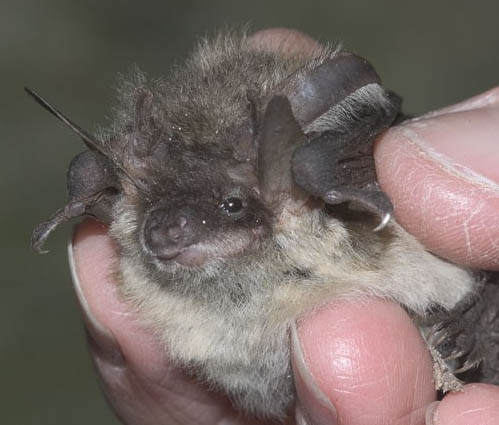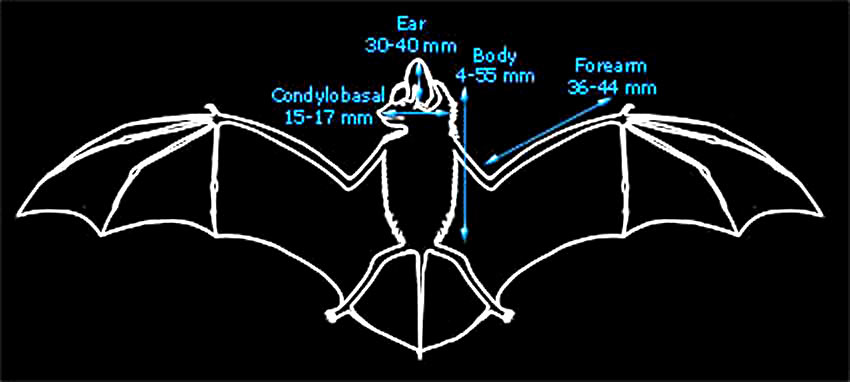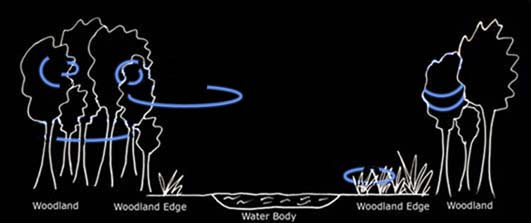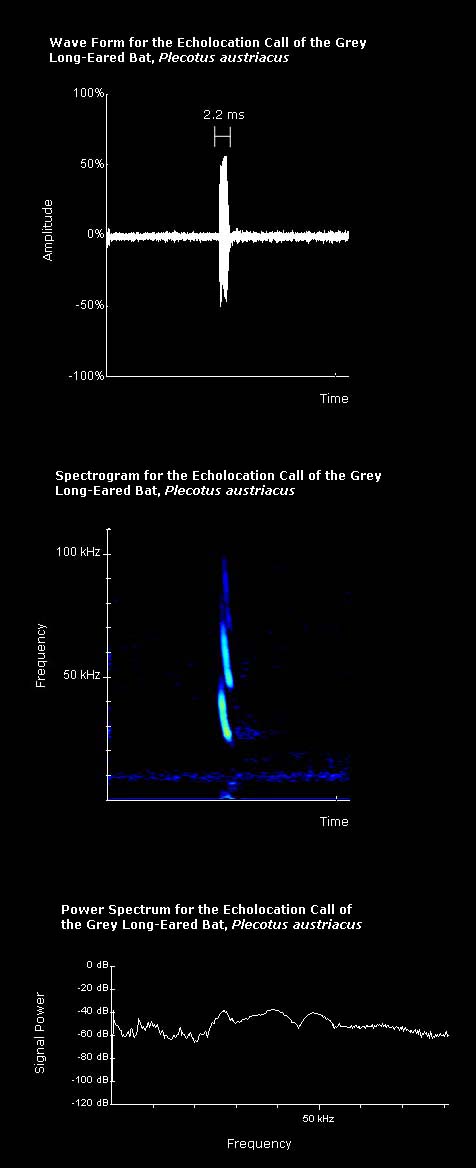Morphological Description
Life History
Distribution
Habitat
Roost Sites and Roosting Patterns
Emergence and Flight Pattern
Foraging Behaviour
Echolocation Calls
Status and Protection |

Note that the ears of the grey long-eared bat are held back in the above photograph. |
|
Morphological Description
- Dorsal fur is medium to dark grey, possibly with a slight brownish tinge. Ventral fur is very pale grey.
- Fur is long.
- Ears are approximately three quarters of the length of the head and body and are longer than 30mm.
- Can be distinguished from the brown long-eared bat by the width of the tragus. The tragus of the grey long-eared bat is greater than 5mm at its widest point.
- Can also be distinguished from the brown long-eared bat by the length of the thumb. The thumb of the grey long-eared bat is less than 6.5mm.
- Average weight (as given by Greenaway & Hutson, 1990) 7-14 g.
The diagram below gives important average body measurements for grey long-eared bats (Greenaway & Hutson, 1990).
|

Back to top |
Life History
- Mating occurs from September to October.
- A single young is born in June or July (Swift, 1991b).
- Maximum age recorded in Europe is 14.5 years (Schober & Grimmberger, 1989).
Back to top
|
Distribution |
|
|
 |
| The British and World distributions are shown by the white areas of the maps above (as given by Richardson, 2000 and Corbet & Harris, 1991 respectively). |
|
Mainly found in the south and south east of England.
Back to top
|
Habitat |
|
• Relatively little is known about the habitat of the grey long-eared bat but it is probably similar to that of the brown long-eared bat.
• Warm valleys and small, open woodland. Often associated with villages and towns.
• The photograph on the left shows a typical habitat of grey long-eared bats.
|
| Roost Sites and Patterns |
- Summer roosts: Nurseries are found from March (Swift, 1991b). Roost in buildings in attics singly
or in small groups in crevices or timbers. May roost with lesser horseshoe bats.
- Winter roosts: Hibernate from October in warm regions of caves and similar environments (Greenaway & Hutson, 1990). May prefer exposed positions to underground sites and the lack of
suitable warm sites may be the reason for the limited distribution of grey long-eared
eared bats in Britain (Swift, 1991b; Greenaway & Hutson, 1990). Usually found
singly hanging freely from the wall but may also roost in crevices. May roost with brown long-eared bats.
Back to top
|
Emergence and Flight Pattern |
• Emerges in the dark and forages sporadically throughout the night.
• Flight is low, 2-5m above ground level (Swift, 1991b).
• Flight is agile and skilful.
Back to top
|
Foraging Behaviour |
- Forages close to the roost in open spaces and occasionally around street lights. May sometimes glean insects from foliage but more often catches prey in free flight.
- The diet of grey long-eared bats mainly consists of Lepidoptera, including many tympanate species. Diptera, predominantly woodland species, are also taken (Vaughan, 1997).
- May use feeding perches.
|
 |
|
Marked in blue on the diagram above is a typical foraging path of grey long-eared bats (based on Russ, 1999).
Back to top
|
Echolocation Calls |
|
|
 |
The echolocation call of grey long-eared bats is frequency modulated. |
|
To listen to the call of the grey long-eared bat click here (recorded in Tuscany, Italy, by Dr Danilo Russo).
Size of sound file: 22.8 KB
|

|
| For details of how the echolocation calls were recorded click here. |
|
Average values for a grey long-eared bat echolocation call, as given by Vaughan et al. (1997), are listed below:
Interpulse interval: 104.2ms
Call duration: 1.7ms
Minimum frequency: 29.8kHz
Maximum frequency: 62.5kHz
The spectrogram on the left shows clear frequency modulation, with the call beginning at high frequency and ending at a lower frequency.
The power spectrum on the left shows that the maximum power of the call is at a frequency of approximately 50 kHz.
|
Back to top
|
|
| Status and Protection
- The British pre-breeding population was estimated at 1000 in 1995 (all in England ) (Harris et al., 1995).
- Very rare in England.
- Grey long-eared bats are at low risk of extinction worldwide (IUCN status, 2001).
- Nursery roosts and habitats should be protected.
- May be threatened by timber treatments and pesticide use.
Back to top
|
 © School of Biological Sciences, University of Bristol 2005. Last modified 24th February 2005. © School of Biological Sciences, University of Bristol 2005. Last modified 24th February 2005. |





 © School of Biological Sciences, University of Bristol 2005. Last modified 24th February 2005.
© School of Biological Sciences, University of Bristol 2005. Last modified 24th February 2005.